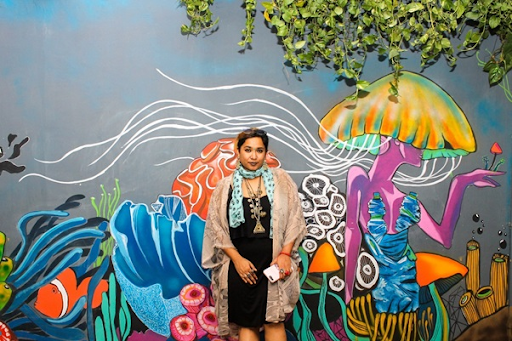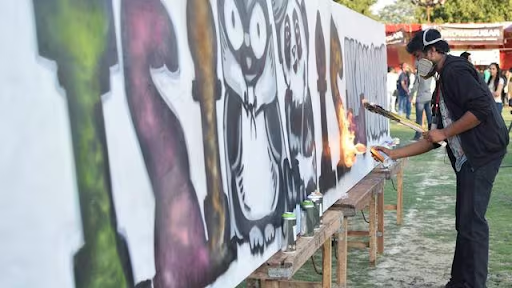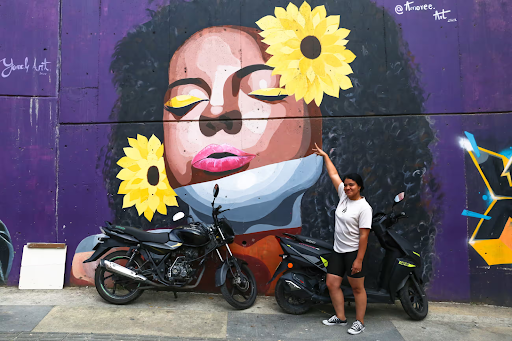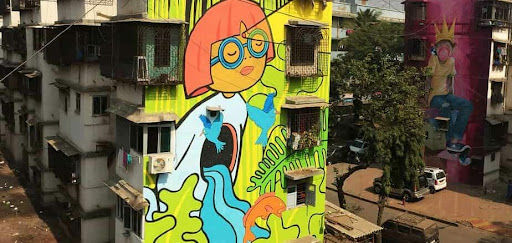Street Art - Helping Women's Voices Shine
- Rupangana Gupta

- Oct 22, 2023
- 3 min read
Murals not only add colour to walls and shine to streets, but also serve as a platform for voicing the plight of the oppressed. They make powerful statements to reflect the social injustices that exist within our communities. An exemplary example of this is the graffiti on street walls that is being used in order to break gender stereotypes.
For ages women have been oppressed in numerous ways, restrictions have been placed, judgements have been heaped on them and amongst all this their voice has somehow gone unheard. Throughout history male voices have told a disproportionately large number of stories. Street wall art is beginning to change the story for women’s voices.
It provides them with a platform, a platform to stand up for their beliefs, a platform to express their issues, a platform to exhibit the pressures they face.

We had the opportunity to talk to Ms. Avantika Mathur. Avantika Mathur a.k.a. WomenPow is a multi-disciplinary artist who has been a household name in the art industry for over a decade. With a strong message of women empowerment, Avantika has used multiple mediums to spread the message far and wide, like canvas series, street art and body painting which has gotten her global recognition. In her words,
“I have never let my gender hold me back from doing the kind of work I wish to do”.
Avantika was deeply passionate about art from a young age. She studied at the University of Philippines and pursued her Masters upon returning to India. It was here that she got inspired to use art for the purpose of empowerment, seeing her fellow female classmates being treated unequally and oppressed in their respective homes.
Upon being asked how street art can create an impact, she shared,
“Street art enables a lot of visibility for art. 1000s of people walk by a street each day and view the murals on the walls. They are very likely to notice it and on many occasions engage with it such as posting a picture of it on social media or following the artist on social media.”
Avantika also remarked that in conversations about female artists, gender should not be the focus of the conversation. Rather, the narrative should be that women are voicing out and using art as a tool to empower themselves.

It isn’t just Avantika that has turned to wall art. Students in many campuses have also taken up initiatives and are using wall art for social change. Recently, Delhi University students painted the campus in rainbow hues, and made art a means to communicate social messages. Kanchan, a B.Com student says, “I think graffiti is cool. And most of the art here depicts women's issues, which is even better.”

Street art has been an excellent tool, even in situations of conflict. Murals in Comuna 13- an area in Medellin, Colombia show us exactly this. Comuna 13 has seen numerous dangerous activities, ranging from a distribution of illegal drugs and harmful substances, a high crime rate, a controversial military operation leading to a loss of lives. While murals depicting this pain and turbulence exist in Comuna 13, these often overlooked the challenges that the women have faced. That’s why a group of women are working towards changing this. They are making artworks that represent the extent of their suffering as mothers and women in Comuna 13.
Despite these strides, there are also challenges that street wall artists encounter on a day to day basis. Financial security might be a concern for some artists. Working late hours especially in the nighttime or in an isolated area poses a safety risk to the artists in certain cities or towns. It is something that they have to be careful about.

“If I am working at night, I always have someone with me and keep Pepper spray handy with me,” said Jas Charanjiva, a prominent wall street artist. “I don’t feel safe working alone at nights and I only go to the neighborhood I know.’’
At times female artists also need to face groups that oppose them or don't want their voice to be heard.
But female artists all across the globe are continuing to make efforts to continue making astounding artwork and making new strides.
Wall art is gradually becoming more common, numerous young artists are attempting to learn it and decorate the walls of the streets while spreading messages of unity and empowerment. Talking to Avantika and reading about several inspirational artists has shown me that this artform has a bright future in India and across the globe.
Change can come in any form, art can be used to express, communicate, educate and most importantly inspire. So be the change you want to see in the world. And as Avantika says - be a changemaker in your own unique way!
Written by Rupangana Gupta






Comments